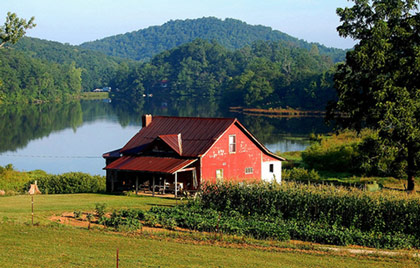 Like some of you reading the Prepper Journal, I have long wanted the ‘Prepper dream’ of a large tract of mostly wooded land, complete with a large stream or river gently rolling through the property. In this imaginary paradise full of wild game and fertile soil, I would set up my modest log cabin complete with all the amenities (underground man cave/survival bunker) that we could purchase or build which would allow us to go off grid and be able to live as self-reliant as possible. Naturally I roll up to my homestead in the woods in my brand new Devolro Tundra, complete with Realtree paint job – family in tow, breathe in the fresh air and smile with contentment.
Like some of you reading the Prepper Journal, I have long wanted the ‘Prepper dream’ of a large tract of mostly wooded land, complete with a large stream or river gently rolling through the property. In this imaginary paradise full of wild game and fertile soil, I would set up my modest log cabin complete with all the amenities (underground man cave/survival bunker) that we could purchase or build which would allow us to go off grid and be able to live as self-reliant as possible. Naturally I roll up to my homestead in the woods in my brand new Devolro Tundra, complete with Realtree paint job – family in tow, breathe in the fresh air and smile with contentment.
For me, those dreams are on hold, but definitely not forgotten.
There are those who are searching right now for the perfect piece of land and who may have already made plans to move their family, but for the large majority of the rest of us, this is simply not possible. Oh, I know there are those out there who will say anything is possible if you just put your mind and priorities to it and I agree that there is truth in that saying. Maybe I should say that it is far too much trouble now for me to do what is necessary to move, for a lot of factors I won’t get into in this post. I did want to discuss going off grid from another standpoint though and that is from the perspective of events or circumstances out of our control.
What if you don’t get to choose when you go off grid. What if the grid suddenly up and leaves you without so much as a dear John letter? For those of us who have dreamed of that self-reliant way of life by that picturesque cabin in the forest, our reality could be our suburban homes are rendered Grid-less in some future disaster and when that happens, will you have what it takes to live off the grid?
There are common elements to living off grid and I want to discuss these today and how you can take steps now in anticipation of a future disruption in the status quo. Today we will begin a five part discussion on the 5 things you need to go off grid and how to make your home prepared for that possibility right where you are, without the trouble of moving or chopping down a lot of trees. Oh, and the Devolro is optional too… unfortunately.
Water

This may come as no surprise to most of you but water is a necessity. If you and “the grid” go through a nasty breakup, you will still need the basics for survival. Water is one of the easiest items to stock up on now, but finding it, collecting it, transporting it and making it safe to drink, make this no trivial item when the taps are shut off.

Source – A source of water is an absolute necessity and as much as I like to point to rain barrels as one potential option, you will need to make sure that the capacity you are collecting is enough to last you from rain to rain. The beautiful thing about rainwater collection is that collection is virtually zero work once you have the system set up and it is possible to get an insane amount of water from the mildest of downpours. For every 1” of rain on 1000 square feet of roof you can collect around 600 gallons. If you have moderate rains, this could keep a family of 4 in water for a long time. (1 gallon per person per day x 30 days) = 30 X 4 people = 120 gallons of water minimum per month. With only one inch of rain and the right capacity of a rain barrel system, this could keep you stocked with plenty of water for 5 months! Double the capacity and you have doubled the supply. The Tank Depot has great slim line water tanks from Bushman that will fit nice and snug to your house and come in several colors that hold 530 gallons of water each. Two of those are an approximately $1700 investment that could hold 1160 gallons.
Not everyone has that much money to plunk down on a thousand gallon water storage tanks so there are other options, sizes and price points. You can purchase nice decorative rain barrels that hold closer to 50 gallons at your local hardware store or purchase used food grade barrels and build your own system from much cheaper. There are more videos of rain barrel videos on YouTube than you can shake a stick at.
Collection – If you are unable to collect rain water and are forced to go acquire it somewhere you will need containers to hold the water you are transporting. One thing to consider here is that water is heavy in quantity. Sure, you can carry that single liter water bottle around all day but if you are humping it to the water hole you probably want to get enough so that your efforts aren’t wasted. At the very least, you don’t want to have to go out every day to get water if you don’t have to. There could be threats to your life going out so take that into consideration.
A means to transport the water is best and I think a heavy duty rolling yard cart would be ideal unless you have your own mules. You could load 20 gallons of water easily in 5 gallon water containers or buckets in one trip and wheel that back to your home. If you had to carry your own water and didn’t have the benefit of a cart, I doubt many people would be carrying more than 5 gallons at a time. Additionally, if you are carrying water without a cart, you want something with handles. Don’t be that guy schlepping off to the water hole with 2 liter Pepsi bottles tied with your paracord around your neck. That would work, but seriously???
Filtration – This is the part of the water problem that will cause more illnesses to survivors after you and the grid are splits-ville I think and that is drinking contaminated water. There are virtually no untainted sources of water unless you tap into a spring right as it is coming out of the ground or a well. For anyone collecting water from a pond, river or stream and even those rain barrels, you will need to disinfect your water. The absolutely easiest way to make a lot of water safe for drinking in my opinion is a gravity filter like the Big Berkey line of water filters.
I have the Berkey light and it doesn’t get much simpler than pouring water in the top. Gravity feeds the water through the special filter elements and the water collects in the bottom reservoir ready for drinking. The only work you have to do in the filtering process is to pour. The filters have a life of about 4 years assuming 4 gallons a day and usually only require gentle cleaning if your water is nasty. You can purchase replacement berkey filters now, to have on-hand.
Options? If you don’t have water filters, you can absolutely boil water or use bleach to disinfect but that takes time, energy (building a fire) or you have to worry that you either have too much or not enough bleach to water ratio. For me, simpler is better.
Tomorrow we will discuss the second aspect of going off the grid. I hope you will come back and join us and as always, please comment with questions or opinions below.
If you found this article useful, please Vote for The Prepper Journal as a top prepper web site.

Copyright Information This information has been made available by The Prepper Journal. Content on this site (unless the work of a third-party) may be shared freely in digital form, in part or whole, for non-commercial use with a link back to this site crediting the author. All links in articles must remain intact as originally posted in order to be republished. If you would like to be notified of new articles, contests and Prepper news, please sign up for our daily newsletter, follow us on Twitter, or Like Us on Facebook.




